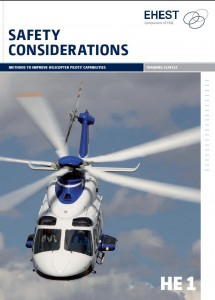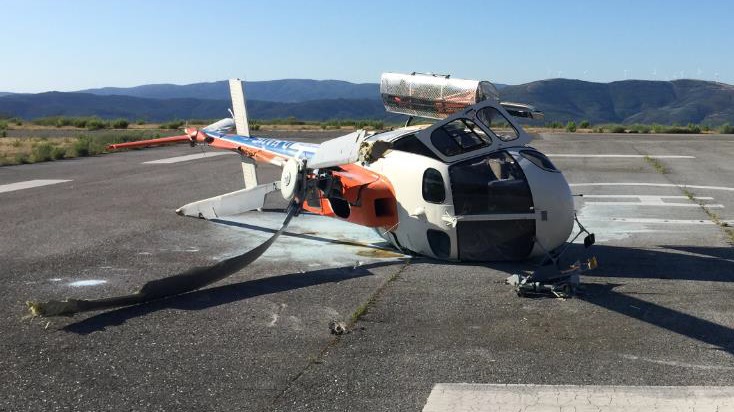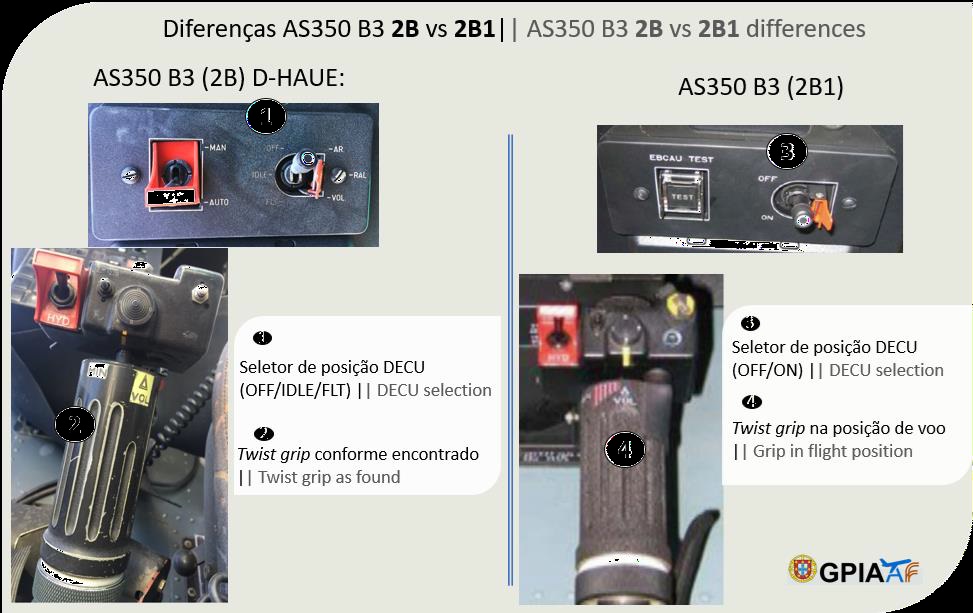AS350B3 Rolls Over: Pilot Caught Out By Engine Control Differences (Helibravo AS350B3 D-HAUE)
On 4 September 2019, Airbus Helicopters AS350B3 D-HAUE operated in Portugal by Helibravo – Aviação for fire-fighting rolled over on take off at Pampilhosa da Serra. One of the 6 persons on board received a minor injury.
The Portuguese accident investigation agency, GPIAAF, say in their safety investigation report that:
According to the pilot’s statements, the engine start-up and flight preparation procedures were normal with no relevant issues to record until the time the Flight Mode was selected, and a sudden increase in engine power was noticed. Immediately soon after, the aircraft begins a vertical movement with some oscillations.
The aircraft rotated 90º clockwise, rose from the ground to a height of about one meter and the pilot could not counteract the low tail attitude and the descent aircraft movement.
The aircraft touched hard on the back right of the skid and a tail rotor strike on the ground occurred.
The aircraft returned to the air and rotated around its longitudinal axis until the main rotor also touched the ground.
The aircraft fell on its right side, about 3 meters ahead of the initial contact point.
From the readings taken from the engine data (VEMD [(Vehicle and Engine Monitoring Display]), it was possible to confirm two main rotor rotational speed peaks above the 448 rpm that is the maximum value recorded by the unit. (note: certification limit for AS350B3 ([Arriel] 2B) main rotor rpm is 390 +4/-5 rpm)
The pilot had flown 1833.5 hours in total, including 1655.5 hours in the AS350B2 and B3 series. Of note is that he had very little experience with the Safran Arriel 2B powered AS350B3 (but more with the Arriel 2B1).
The operator uses, mainly during the firefighting season, a mixed fleet of AS350 B3 helicopters equipped either with Arriel 2B and Arriel 2B1 engines (MOD 073254), that have different procedures for initiating the flight mode.
The crashed aircraft was equipped with an Arriel 2B engine (pre-mod 073254) in which engine control is performed via a Digital Engine Control Unit (DECU) with single channel governor and mechanical redundant system.
Differences in the operation of the various aircraft models are addressed by the operator in pre-season training…
One of the main differences between aircraft versions (2B and 2B1), and relevant to the event, are the pre-engine start-up procedures and takeoff power selection for the FLIGHT mode.
The AS350B3 helicopter equipped with an Arriel 2B engine has a single-channel engine governor and DECU back-up MANUALLY controlled using the mechanical system of the twist grip. As stated on the flight manual section 4.1, the twist grip must be in the “FLIGHT” detent before carrying out the starting procedure. The flight mode selection is done using the three-position selector (OFF-IDLE-FLT/AR-RAL-VOL).
In contrast:
…the AS350B3 helicopter equipped with an Arriel 2B1 engine has a dual-channel engine governor and an automatic backup control (EBCAU [Engine Back-Up Control Ancillary Unit]); the simplified twist grip must be in the “IDLE” detent before carrying out the starting procedure (section 4.3 of flight manual). The flight mode selection is done using the two-position selector (OFF-ON) And then rotate the twist grip to the FLIGHT/VOL position.
On the accident aircraft with the older model (2B) the pilot needs to select the three position start-selector in the ceiling ([marked on the illustration below] 1) to Off/Idle/Flight, to properly select idle for engine start, then select the flight position (FLT/VOL) to initiate the flight phase with no action on the collective twist grip (2), maintaining the flight (VOL) on the twist grip mode during normal operations.
For the 2B1 model with dual channel control, a simple ON/OFF switch (3) (also in the ceiling) needs to be selected for engine start up to idle, and then select Gnd/Flight (VOL) with the grip (4) to FLT/VOL mode.
The aircraft was equipped with the mechanical stop (red pushbutton on the grip), however the modifications 073084 and 073222 were not incorporated (automatic release of the emergency range in case of governor failure). In this case the emergency range may have been inadvertently activated if the mechanic stop was not correctly engaged or accidentally disengaged.
On ground in the 2B model, if inadvertent grip rotation occurs…the engine spool-up and can produce an overspeed of the Main Rotor. The manufacturer confirmed to have some cases where this overspeed has generated a ground resonance when the collective is locked. However, if the collective is not locked the vibration can produce the up movement of the collective and an inadvertent aircraft takeoff may occur.
Airbus Helicopters released Safety Information Notice No. 3268-S-00 on 15 November 2018, concerning cases of inadvertent take off. Previously:
Eurocopter Lettre-Service LS 1702-71-05 summarizes the various types of twist grip and their use on an actual failure or training for the AS350B3 helicopters equipped with Arriel 2B or Arriel 2B1 engines.
Eurocopter, in the Information Notice 2169-I-67, rev.0 from June 2010, recommended operator adopt applicable modifications to make the operation of the twist grip more reliable and to standardize the AS350 B3 helicopters with Arriel 2B engine.
Although the accident investigators don’t comment on it, as the helicopter was German registered it is highly likely to have been on charter for the fire-season. This would make fleet standardisation harder unless that was an aircraft selection criteria.
GPIAAF Conclusions
The pilot rotated the twist grip, engaging the manual engine control mode and commanded the engine to MAX rpm leading the main rotor to reach 448 rpm and with sufficient generated lift, the aircraft started a “bounce”, even without a collective pilot input. It is likely that the collective control was not properly locked.
They say contributions were:
- the different AS350B3 2B and 2B1 models’ configurations
- grip modification (073084) was not embodied on aircraft
- pilot recent flight experience on the 2B1 model and the lack of recognition on the 2B1 to 2B models differences
- no onboard checklist adherence.
Noting this was a firefighting operation, additionally GPIAAF comment on human factors:
The readiness factor and focus on meeting contractual milestones in preparation and departure for the aerial mission, with a new team and environment for the pilot, may have contributed to diverting attention from the aircraft’s essential piloting actions. …in pressure situations, where there is an excessive demand for cognitive resources, the human being reverts to an automatic mode of operation using the knowledge that is more prominent in his memory by experience that, in this case, led him to take an action based on the mental model of another aircraft configuration.
Safety Action
GPIAAF report that:
Helibravo, Aviação Lda, implemented at all operational bases a specific procedure to make sure that the ground staff, when assisting the aircraft, always maintain visual contact with the pilot, until both (pilot and ground staff) signalising the ready to flight (thumbs-up). The ground staff will always keep the aircraft in sight until it leaves the manoeuvring area.
The specific relevance of this action to the accident is not articulated.
GPIAAF Safety Recommendation
No PT.SIA 2019-008: Helibravo, Aviação Lda, should ensure that all pilots are properly trained and knowledgeable about the equipment they operate, their differences and particularities, especially on the fleet reinforcement status aircraft. The operator should also take the necessary actions to standardize its AS350B3 fleet.
Other Safety Resources
- Be Careful If You Step Outside!: Unoccupied Rotors Running AS350 Takes Off
- AS350B3 Dynamic Rollover When Headset Cord Snags Unguarded Collective
- Bear Paws Claw Reindeer Herding Bell 206
- US HEMS EC135P1 Dual Engine Failure: 7 July 2018 – another case of variant confusion
- EC135P2+ Loss of NR Control During N2 Adjustment Flight
- EC135P2 Spatial Disorientation Accident
- Misassembled Anti-Torque Pedals Cause EC135P1 Accident
- AAIB Report on Glasgow Police EC135T2+ Clutha Helicopter Accident
- Maintenance Misdiagnosis Precursor to EC135T2 Tail Rotor Control Failure
- Accident Report: Fatal Police Helicopter Double Engine Flameout Over City Centre
- US Police Helicopter Night CFIT: Is Your Journey Really Necessary?
- HEMS S-76C Night Approach LOC-I Incident
- AS350 Tail Rotor Control Incident, Grand Caymen
- Austrian Police EC135P2+ Impacted Glassy Lake
- Dim, Negative Transfer Double Flameout
- BK117B2 Air Ambulance Flameout: Fuel Transfer Pumps OFF, Caution Lights Invisible in NVG Modified Cockpit
- EC130B4 Destroyed After Ice Ingestion – Engine Intake Left Uncovered
- US Fatal Night HEMS Accident: Self-Induced Pressure & Inadequate Oversight
- Firefighting Helicopter Wire Strike
- Wayward Window: Fatal Loss of a Fire-Fighting Helicopter in NZ
- Helicopter Tail Rotor Strike from Firefighting Bucket
- When Habits Kill – Canadian MD500 Accident
- HF Lessons from an AS365N3+ Gear Up Landing
- UPDATE 27 December 2020: Fire-Fighting AS350 Hydraulics Accident: Dormant Miswiring: an accident to another D registration Helibravo AS350
On error management:
…and our review of The Field Guide to Understanding Human Error by Sidney Dekker presented to the Royal Aeronautical Society (RAeS): The Field Guide to Understanding Human Error – A Review
This EHEST leaflet covers the following subjects:
– Degraded Visual Environment (DVE),
– Vortex Ring State (VRS),
– Loss of Tail Rotor Effectiveness (LTE),
– Static & Dynamic Rollover, and
– Pre-flight planning Checklist.





Recent Comments